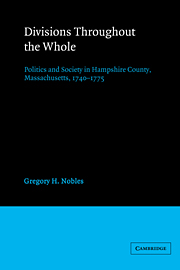Book contents
- Frontmatter
- Contents
- Preface
- Introduction
- 1 Family power and political relations in Hampshire County
- 2 The Hampshire County ministry and the Great Awakening: from revival to reaction
- 3 The revivalist removed
- 4 The legacy of religious dissent
- 5 New settlements in an unsettled society
- 6 The politics of parochialism
- 7 Revolution in the neighborhood
- Appendix
- Notes
- Bibliographical essay
- Index
2 - The Hampshire County ministry and the Great Awakening: from revival to reaction
Published online by Cambridge University Press: 30 September 2009
- Frontmatter
- Contents
- Preface
- Introduction
- 1 Family power and political relations in Hampshire County
- 2 The Hampshire County ministry and the Great Awakening: from revival to reaction
- 3 The revivalist removed
- 4 The legacy of religious dissent
- 5 New settlements in an unsettled society
- 6 The politics of parochialism
- 7 Revolution in the neighborhood
- Appendix
- Notes
- Bibliographical essay
- Index
Summary
The ministers of the county were the first to feel the effects of disharmony and disorder. Throughout the early part of the eighteenth century the Hampshire clergy had seemed a fit counterpart to the county's secular leadership, a well-ordered, unified body led by the forceful personality of Solomon Stoddard. Stoddard had given his colleagues a common organization and a common ecclesiastical practice that bound them together and helped them stand apart from the rest of the New England ministry. Moreover, he had provided an impressive model of the minister as patriarch and evangelist, always able to maintain the delicate balance between institutional stability and spiritual activity. By the 1730s, however, the position of other county ministers became increasingly unsteady. Stoddard was dead, and there was no one, not even his grandson Jonathan Edwards, who could take his place above the rest. Ironically enough, as Edwards led Hampshire ministers in the widespread religious revivalism Stoddard had hoped to achieve, the local clergy experienced an increasing loss of confidence and consensus. The heightened religious upsurge that swept the county in the late 1730s and early 1740s led also to heightened religious unrest, creating disorder in the ministers' respective congregations and division in their collective organization. In many ways the Great Awakening proved to be a rude awakening for members of the Hampshire clergy, and they began to realize just how vulnerable they could be.
- Type
- Chapter
- Information
- Divisions throughout the WholePolitics and Society in Hampshire County, Massachusetts, 1740–1775, pp. 36 - 58Publisher: Cambridge University PressPrint publication year: 1983

